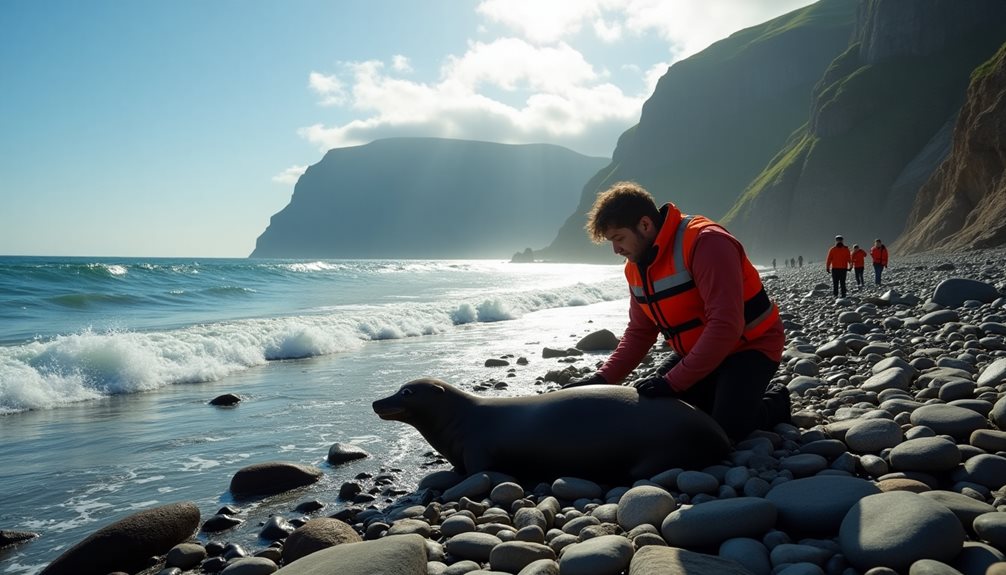Explore the captivating coastal regions of Russia, where diverse marine ecosystems and rich cultural traditions thrive. From the icy Arctic to the vast Pacific and the serene Baltic seas, these areas are teeming with unique biodiversity and steeped in historical fishing practices. Institutions like the Shirshov Institute are at the forefront of marine science and conservation, uncovering the intricate connections between local communities and their environment. Discover the complexities of these coastal wonders and the profound implications they hold for future marine stewardship and the preservation of indigenous heritage.
Introduction

Russia’s extensive coastline stretches across three major seas: the Arctic, Pacific, and Baltic, serving as a vital interface between terrestrial and marine ecosystems.
These coastal ecosystems exhibit remarkable marine biodiversity, hosting a variety of species essential for ecological balance. Indigenous knowledge plays an important role in understanding these environments, providing insights into sustainable practices and ocean conservation efforts.
In addition, the intricate patterns of maritime navigation along these shores reveal historical and contemporary connections to global trade and exploration.
Collectively, these elements illustrate the profound significance of Russia’s coastline in fostering scientific research and promoting a harmonious relationship with the ocean.
Why Visit Russia’s Seacoasts?
What draws travelers to the seacoasts of this vast nation? The allure lies in the intricate coastal ecosystems that support diverse marine life and the rich maritime history that shapes cultural identities.
Visitors engage with ocean conservation efforts, gaining insights into the environmental challenges facing these unique habitats. Indigenous practices further enhance the experience, offering a glimpse into sustainable living harmonized with nature.
Additionally, research collaborations between international scientists and local institutions foster a dynamic exchange of knowledge, making these coastal regions pivotal for marine science.
Collectively, these elements create a compelling reason to explore Russia’s remarkable seacoasts.
Marine Science and Cultural Heritage
While the interplay between marine science and cultural heritage is often overlooked, it is a fundamental aspect of understanding coastal regions in Russia.
The rich marine biodiversity found in these waters is intricately linked to maritime traditions and indigenous knowledge, which have shaped local communities for centuries.
Coastal exploration reveals not only ecological insights but also a mosaic of cultural narratives that inform ocean conservation efforts.
Seacoast Science Center Overview
The Seacoast Science Center, situated in the United States, serves as a prominent model for marine education and conservation efforts that resonate with the scientific initiatives found throughout Russia’s coastal regions.
This center emphasizes seacoast ecology, showcasing the intricate relationships within marine biodiversity. It actively addresses ocean pollution through community engagement and innovative research collaborations.
Mission and Educational Programs
Dedicated to advancing marine education and conservation, institutions in Russia’s coastal regions implement a variety of mission-driven programs aimed at fostering a deeper understanding of marine ecosystems.
These marine education initiatives encompass extensive coastal ecosystem studies, enhancing knowledge of biodiversity and environmental dynamics.
Ocean conservation programs seek to mitigate human impact while promoting sustainable practices.
In addition, robust public outreach efforts engage communities, raising awareness of marine issues.
Scientific collaboration projects further strengthen the research framework, encouraging interdisciplinary partnerships that enhance data collection and analysis.
Collectively, these efforts exemplify a commitment to preserving Russia’s unique coastal heritage for future generations.
Marine Mammal Rescue and Conservation

Numerous initiatives across Russia’s coastal regions focus on the rescue and conservation of marine mammals, reflecting a commitment to protecting these crucial species.
Marine mammal rehabilitation efforts are essential, employing specialized techniques to aid injured or stranded individuals.
Conservation strategies encompass habitat restoration projects aimed at enhancing ecosystems that support diverse species.
Public awareness campaigns educate citizens about the importance of marine life, fostering community involvement in conservation.
Additionally, species protection programs are implemented to monitor populations and mitigate threats, ensuring the sustainability of these majestic animals.
Collectively, these efforts signify a robust approach to marine conservation in Russia’s coastal domains.
Interactive Exhibits and Ocean Health
Although interactive exhibits serve as engaging tools for public education, their real impact lies in fostering a deeper understanding of ocean health and the myriad challenges facing marine ecosystems.
Interactive oceanography displays offer hands-on experiences, enabling visitors to engage with marine ecosystem simulations that illustrate complex interdependencies. These digital conservation tools enhance awareness of biodiversity loss and climate change effects.
Educational outreach programs empower communities, igniting interest in oceanography career pathways. By integrating technology and education, these exhibits not only inform but also inspire action, equipping individuals with the knowledge necessary to advocate for sustainable practices and protect fragile marine environments.
Nearby Attractions
While exploring Russia’s coastal regions, visitors encounter a diverse array of attractions that highlight the intersection of natural beauty and scientific inquiry.
Coastal festivals celebrate marine heritage, offering cultural insights alongside vibrant local traditions. Enthusiasts of marine photography can capture stunning vistas and rich biodiversity, while ocean kayaking provides an intimate experience of the coastline’s ecosystems.
Wildlife observation opportunities abound, allowing visitors to witness the unique fauna that thrives in these environments. Additionally, fishing excursions present a practical engagement with regional practices, underscoring the sustainable use of marine resources and fostering a deeper understanding of the intricate balance within coastal ecosystems.
Odiorne Point State Park Natural Beauty
Odiorne Point State Park, with its stunning coastal landscapes, emerges as a demonstration to the intricate interplay between natural ecosystems and human appreciation for the environment.
This area showcases diverse coastal ecosystems that support rich marine biodiversity, offering a sanctuary for various species. The park’s scenic landscapes, characterized by rocky shorelines and tidal pools, provide essential insights into ocean conservation efforts.
Visitors encounter environmental challenges faced by these ecosystems, fostering a deeper understanding of the delicate balance within coastal habitats.
Odiorne Point serves as a crucial reminder of the importance of preserving such natural wonders for future generations.
Local Coastal Wildlife and Habitats
Coastal wildlife and habitats represent a dynamic mosaic of interactions within marine ecosystems, shaped by both natural processes and human influences.
Russia’s coastal ecosystems harbor rich marine biodiversity, including myriad species of fish, mammals, and invertebrates. The interplay between these species illustrates the complexities of their habitats, which are essential for sustaining ecological balance.
Wildlife conservation efforts focus on habitat preservation, ensuring that these environments remain resilient against anthropogenic pressures.
Ecological research in these regions provides critical insights into the health of marine ecosystems, driving informed strategies for sustainable management and enhancing public awareness of the importance of coastal habitats.
Community Events and Cultural Experiences

As communities along Russia’s extensive coastlines engage in various cultural events, they showcase a rich fabric of traditions that reflect their maritime heritage.
Community festivals celebrate local cuisine, offering visitors a taste of seafood delicacies and traditional dishes. Beach cleanups not only promote environmental stewardship but also foster communal bonds.
Artistic expressions emerge through maritime art, illustrating the profound connection between inhabitants and the sea. Additionally, cultural workshops provide opportunities for skill sharing, from crafting traditional fishing nets to painting coastal landscapes.
These events collectively enhance cultural understanding and reinforce the importance of preserving both heritage and the marine environment.
Russian Coastal Science and History
While exploring the interconnections between Russia’s coastal geography and its scientific advancements, it becomes evident that the nation’s maritime history is deeply intertwined with its oceanographic research.
Coastal ecosystems serve as critical habitats, showcasing a wealth of oceanic biodiversity that has historically supported indigenous fishing practices. This rich heritage informs contemporary maritime conservation efforts, emphasizing the need to protect these essential resources.
Moreover, historical navigation routes have shaped coastal development, influencing both cultural and scientific progress. As a result, Russia’s coastal landscape stands as a reflection of the symbiosis between its storied past and ongoing commitment to oceanographic exploration.
Shirshov Institute of Oceanology’s Role
Recognized as a cornerstone of marine research in Russia, the Shirshov Institute of Oceanology plays a pivotal role in advancing the understanding of oceanic processes and ecosystems.
Through extensive Shirshov research initiatives, the institute conducts marine biodiversity studies that elucidate species interactions and habitat dynamics. Its commitment to oceanographic technology advancements enhances data collection and analysis capabilities.
In addition, the institute undertakes environmental impact assessments critical for sustainable development. Engaging in collaborative international projects, the Shirshov Institute fosters a global exchange of knowledge, positioning itself as a leader in marine science and promoting a deeper understanding of the world’s oceans.
Historical Maritime Routes and Exploration
The rich history of maritime routes and exploration in Russia highlights the country’s longstanding connection to the sea and its strategic importance in global trade and navigation.
Historical navigation, particularly along the Arctic and Pacific coasts, facilitated extensive maritime trade networks, fostering economic growth.
The exploration impact is evident in the advances made in ancient shipbuilding techniques, which enabled longer voyages.
Additionally, coastal cartography evolved considerably, enhancing navigational accuracy.
These elements collectively underscore Russia’s role in shaping maritime history and its enduring legacy in exploration, emphasizing the intricate relationship between geography and the development of its coastal societies.
Indigenous Coastal Cultures and Traditions
How have the indigenous coastal cultures of Russia adapted to their maritime environment over centuries? These communities have thrived through subsistence fishing, relying on ancestral knowledge to navigate local waters.
Indigenous traditions are preserved through cultural storytelling, connecting generations and reinforcing communal identity. Coastal festivals celebrate seasonal cycles, showcasing vibrant expressions of heritage.
Traditional crafts, such as intricate fishnet weaving and boat building, highlight practical skills developed over time. The interplay of ecological awareness and cultural practices underscores the resilience of these cultures, allowing them to maintain their unique identities while fostering a profound relationship with the oceanic landscape surrounding them.
Practical Travel Tips
When planning a visit to Russia’s coastal regions, travelers should prioritize thorough preparation to navigate the diverse environments and cultural landscapes effectively.
Key packing essentials include layered clothing, waterproof gear, and local currency.
Transportation options vary, with regional flights, trains, and ferries facilitating access to remote areas.
Engaging with local cuisine, from fresh seafood to traditional dishes, enhances the cultural experience.
Safety guidelines recommend understanding local customs and potential wildlife encounters.
Weather considerations are significant; coastal climates can shift rapidly, so checking forecasts and being adaptable is essential for a fulfilling and safe exploration of Russia’s coastal science wonders.
Best Times to Visit Coastal Regions
Understanding the ideal times to visit Russia’s coastal regions can greatly enhance the overall experience.
The best travel months typically span late spring to early autumn, aligning with favorable seasonal weather patterns. Climate considerations, such as mild temperatures and reduced precipitation, make these months optimal for exploration.
Peak tourist seasons often coincide with local festivals, enriching cultural experiences while also leading to crowded attractions. Visitors should plan accordingly, balancing the desire for vibrant festivities with the need for tranquility.
Ultimately, awareness of these factors guarantees a rewarding journey through the enchanting coastal landscapes of Russia.
How to Access Marine Science Centers
Accessing marine science centers in Russia involves traversing a complex network of institutions dedicated to oceanographic research and education.
These centers often rely on marine research funding to facilitate their work, fostering oceanographic collaborations both domestically and internationally. Visitors can engage with various environmental education initiatives that highlight the significance of coastal policy impacts on marine ecosystems.
Many centers are linked through international marine partnerships, enhancing their research capabilities and outreach programs. Guiding through these institutions requires understanding their specific missions and objectives, ensuring that inquiries align with the broader goals of ocean conservation and sustainable development in Russia’s coastal regions.
Cultural Etiquette and Language Tips
Engaging with marine science centers in Russia necessitates an awareness of local cultural etiquette and language nuances. Understanding language basics, such as common greetings and polite expressions, facilitates smoother interactions.
Dining etiquette is pivotal; guests should wait for the host to initiate toasts and avoid discussing sensitive topics. Gift giving is customary, with thoughtful, modest gifts appreciated, particularly when visiting homes.
Additionally, communication styles may vary, with directness valued in professional settings, while a more reserved approach is typical in social contexts. Recognizing these cultural nuances enhances the overall experience and fosters respectful exchanges within Russia’s scientific community.
Russia’s Coastal Conservation Legacy
The intricate relationship between Russia’s coastal ecosystems and its scientific initiatives is complex, yet it is clear that the nation’s commitment to marine research and conservation is essential for addressing environmental challenges. By integrating indigenous knowledge with modern ocean policy, Russia fosters marine biodiversity and enhances coastal resilience. The promotion of ecological tourism further supports sustainable practices, engaging local communities and raising awareness of the importance of preserving these crucial ecosystems.
As Russia continues to explore its coastal wonders, the synergy between scientific inquiry and conservation efforts will be pivotal in safeguarding the future of its marine environments. Visitors traversing Russia’s extensive coastline encounter a profound ocean legacy that is intricately woven into the nation’s cultural and historical fabric. This legacy emphasizes ocean conservation and the importance of preserving marine biodiversity within diverse coastal ecosystems. Indigenous practices, passed down through generations, reveal a deep understanding of sustainable interactions with these environments.
Historical exploration of the coastline has fostered an appreciation for the intricate balance between human activity and nature. Together, these elements reflect a complex narrative that invites visitors to engage with Russia’s rich maritime heritage while advocating for the responsible stewardship of its oceanic resources. A significant aspect of Russia’s coastal regions is their potential to inspire ocean stewardship among both locals and visitors. Through ocean conservation initiatives, these areas exemplify effective marine research collaborations that prioritize coastal biodiversity preservation. The integration of indigenous knowledge enhances sustainability practices, fostering a deeper understanding of local ecosystems.
Sustainable fishing practices are promoted, ensuring that economic activities align with ecological integrity. By engaging with these efforts, individuals can cultivate a sense of responsibility towards marine environments. Ultimately, Russia’s coastal landscapes serve as a crucial platform for educating and mobilizing communities in the pursuit of long-term ocean stewardship.





